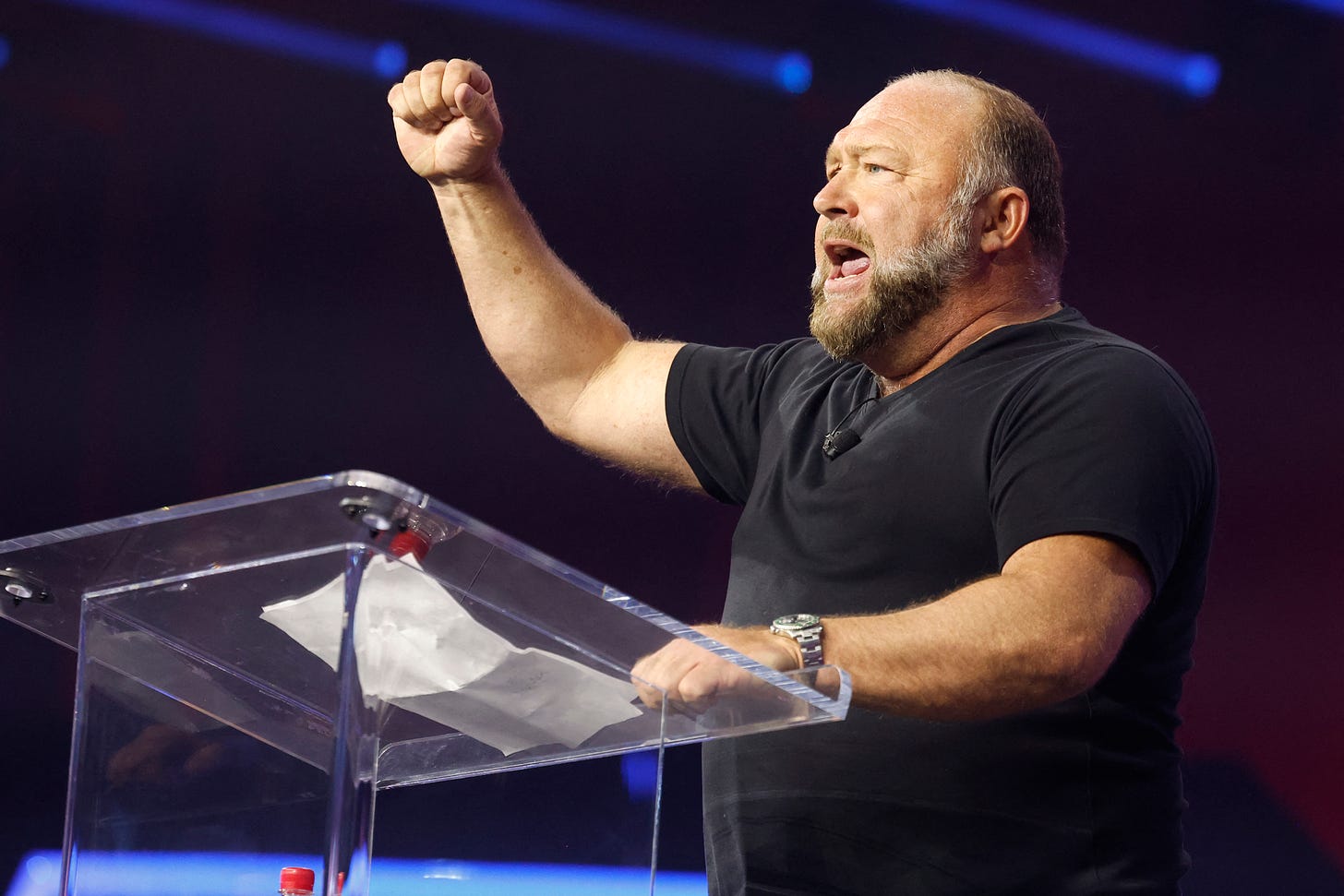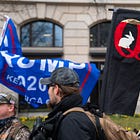How Alex Jones dodged accountability again
A leading purveyor of hate keeps gaming the legal system.

PN is a reader-supported publication made possible by paid subscribers. Appreciate our independent journalism? Then please sign up to support us.
Judge Christopher Lopez last Friday booted Infowars out of bankruptcy. It was mostly a win for hate purveyor Alex Jones, who within hours of the December 14, 2012, murder of 26 people at Sandy Hook Elementary School called their families “crisis actors” seeking to gin up support for gun control.
Jones persisted with his grotesque lies even as the grieving parents faced an avalanche of harassment and threats from his deranged fans. Then he abused the litigation process in state courts, refusing to cooperate with discovery for years on end and making a mockery of their grief on air during the trials. And then he forced them to litigate for two years in bankruptcy court.
At the end of last week’s hearing, Judge Lopez was practically in tears when he granted the motion. But in reality, he had no choice.
How did it come to this?
In 2018, two sets of Sandy Hook parents sued Jones and Free Speech Systems (FSS), Infowars’ parent company. One set filed in Texas state court, the other in Connecticut. Jones doggedly refused to cooperate with discovery, earning himself twin default judgments in 2021, meaning that the jurors were instructed that the defendant had defamed the victims, and their only task was to determine how big a check he should have to write for it.
Approximately five minutes after defaulting, Jones began frantically moving money out of FSS. Much of the cash went to a Nevada company known as PQPR, LLC, which functioned as a liability firewall between the “supplement” side of Jones’s business and the “conspiracy” side.
In 2021, PQPR suddenly “remembered” that it had failed to bill Infowars since, say, ever for the colloidal silver and beet tincture that Jones sold on his website while peddling his lies. PQPR’s “bill” was for roughly $54 million, and FSS rushed to sign two notes securitizing that debt — that is, putting PQPR first in line to get paid. This was highly convenient for Jones, since he and his parents own PQPR. In essence, he was was claiming the right to siphon off every penny of FSS’s earnings, leaving nothing for the Sandy Hook families.
The plaintiffs promptly filed a lawsuit in state court under the Texas Uniform Fraudulent Transfer Act (TUFTA), accusing Jones of looting FSS and shiftings its assets to entities controlled by him and his family. Two years later, a federal bankruptcy trustee recommended that the court disregard the PQPR promissory notes, since PQPR and FSS were functionally the same company.
The first bankruptcy
In April 2022, on the eve of jury selection in Texas, Jones declared bankruptcy for three worthless shell companies which had been named as codefendants in the Sandy Hook litigation. It’s customary to sue every related entity to ensure that no potential source of damages goes untapped. But because a bankruptcy filing automatically stays a civil suit against the debtor, this had the effect of delaying Jones’s first trial.
Jones’s plan was to force the plaintiffs to settle for pocket change, and he wasn’t subtle about it.
“We’re turning to the bankruptcy courts to compel the plaintiffs to estimate the value of their claims in open court by discernible evidentiary standards,” his lawyer Norm Pattis babbled to the Wall Street Journal. “The plaintiffs have turned this litigation into a macabre morality play and have refused to negotiate in good faith. We hope they will show respect to the federal courts.”
A note from Aaron: Working with brilliant contributors like Liz takes resources. To support our independent journalism, please click and become a paid subscriber.
Jones’s lawyers proposed a $10 million litigation trust to settle all his claims — an amount which wouldn’t come close to paying the lawyers for the time they spent chasing him over four years. Instead the plaintiffs dropped the LLCs from the state suits, and Jones skulked out of bankruptcy court with his tail between his legs.
But not for long!
The second bankruptcy: FSS
On July 29, 2022, in the middle of the first Sandy Hook trial in Texas, FSS declared bankruptcy.
The timing of this was particularly fortuitous, because it allowed the company to file under Subchapter V of Chapter 11 of the Bankruptcy Code. Chapter 11 envisions a reorganization, wherein the debtor comes to an agreement with his creditors and emerges as a going concern. Subchapter V is a streamlined, expedited process designed for “Mom and Pop” shops with debts of less than $7,500,000. The code makes an exception for debts to “affiliates or insiders,” like, say, a $54 million debt to a drug supplier wholly owned by Alex Jones and and his parents.
Had Jones waited until after the verdict was rendered, the damage award would have made FSS ineligible for Subchapter V. And indeed Jones bragged on air that all FSS had to do is spend a few months in Subchapter V and his company would be free of the Sandy Hook debts.
The third bankruptcy: Alex Jones
After the Connecticut plaintiffs got their day in court, the total judgments against Jones and FSS totaled $1.5 billion. Jones then filed for personal bankruptcy under Chapter 11, but this time it was different. While before, his aim was to delay the trials, now his goal was to ensure that the Sandy Hook parents could never collect on their verdicts.
For two years, Jones battled the Sandy Hook parents in Judge Lopez’s Houston courtroom. During that time, the parents scored some remarkable victories. Most importantly, they got the judge to rule that the bulk of the $1.5 billion damage award is not dischargeable in bankruptcy like normal debts. It would be bad public policy to allow individuals to commit torts and then demand that a bankruptcy judge clear the tab, and so debts for “willful and malicious injury” are exempted from the general rule.
Jones never intended to come to terms with his victims/creditors, and his plan to speedrun the bankruptcy and emerge debt-free was DOA with the non-dischargeability ruling. And so he shifted his tactics, taking advantage of the moratorium on collections even as he forced the plaintiffs to pay their lawyers to engage in round after round of motions and hearings.
This was not wholly unwelcome to the plaintiffs, who were able to wrest control of FSS by getting a chief restructuring officer (CRO) appointed by the court. CRO Patrick Magill essentially cut off the money spigot to Jones by slashing his compensation and ditching PQPR as the drug supplier. (Jones has now switched to flogging supplements sold by his father under the brand name “Dr. Jones’ naturals,” explicitly pitching it to his fans as a way to support him without fear that the money will go to the Sandy Hook parents.)
But it’s not the bankruptcy judge’s job to supervise an indefinite stalemate so that the debtor can avoid paying his creditors. Nor is it his job to help those creditors inflict pain on the debtor in hopes that he’ll decide to give up hate speech and get into a different line of work.
The dam breaks
Things came to a head last week thanks to two signal developments.
First, Judge Lopez announced at a hearing on May 21 that he was inclined to dismiss the FSS case because there was no hope of approving a plan of reorganization.
Then, on June 5, Jones moved to convert his personal bankruptcy from a Chapter 11 reorganization to a Chapter 7 liquidation, under which his assets would be sold off, with the proceeds distributed to his creditors. After this, he immediately took to the air to howl that they’d forced him to sell his beloved ranch, while neglecting to mention that he was the one who filed the motion and put the property up for sale.
This confluence of events splintered the Texas and Connecticut parties, who had heretofore presented a united front. The Connecticut plaintiffs opposed dismissal, and instead begged the court to convert FSS’s bankruptcy to a Chapter 7. They would essentially shut down Infowars and sell it for parts, under the aegis of the court. Meanwhile the Texas plaintiffs agreed with Judge Lopez (and Jones himself) that the FSS case should be dismissed in its entirety.
This fracturing would appear to be because the two sets of plaintiffs have different incentives.
The Connecticut plaintiffs, with their $1.4 billion award, know that they’re never going to get paid in full — Jones is rich, but he’s not a billionaire. But as the largest creditor by far, they’ll be entitled to a huge percentage of any cash that Judge Lopez and the bankruptcy trustees shake loose. And if they’re never really going to get paid, anyway, they can at least make it as unprofitable as possible for Jones to stay in the bile-spewing business.
The Texas plaintiffs face a very real prospect that the state court will knock their damages down to $4-5 million — an amount they absolutely could collect from Jones. But even at $50 million, their claim is still dwarfed by the Connecticut award, and they’ll be entitled to a small pro rata share of anything Jones and FSS disgorge in bankruptcy. They’re better off going to a state court and moving to seize Jones’s assets immediately, ensuring that they get paid now and in full.
The hearing
On Friday morning, Judge Lopez granted Jones’s motion to convert to a Chapter 7 liquidation, meaning that his assets will be sold and the proceeds distributed among his creditors. Jones had the absolute right to convert, and that order was never in question.
The afternoon session was quite a bit more contentious, however, with the Connecticut plaintiffs warning of the proverbial “race to the courthouse,” pitting the two sets of Sandy Hook plaintiffs against each other as they scrabble to collect against FSS if the case was dismissed. The Texas plaintiffs essentially advocated for exactly that, demanding that the court put an end to this purgatory and let the parties “pursue their state remedies” — that is, file liens in state court and grab what they can.
In court, Judge Lopez acknowledged the reality that he was essentially boxed in, both by the parameters of the US Bankruptcy Code and by Jones’s bad faith manipulation of the system. Subchapter V, which is supposed to get debtors into and out of court quickly, does not allow the judge to babysit the parties forever. And if the debtor refuses to come to an agreement of reorganization with his creditors, there’s really no role for the court in the process.
Lopez also acknowledged (if tacitly) the twin tensions at the heart of this case. First, to have any hope of paying back the plaintiffs, Jones will have to continue tearing up the fabric of American society, flogging conspiracy theories and outright lies that paint a target on other innocent backs. And second, three of the major parties in these cases — FSS, PQPR as a major creditor, and Jones himself — purported to take adversarial positions, but were in fact the exact same person.
“There’s been lots of talk of whether Jones would regain control of his business, but the reality is he never really lost it,” Judge Lopez conceded.
“This is one of the more difficult cases I’ve had,” he sighed, noting that hated to disappoint the Connecticut families so close to Father’s Day. And yet, at the end of the day, that’s what he did, dismissing the FSS bankruptcy.
“When you look at it, I think creditors are better served in pursuing their state court rights,” he said.
So, now what?
Now, it gets even uglier.
The Sandy Hook parents will be in a race to attach FSS’s assets. The Chapter 7 trustee will sell off whatever Jones hasn’t managed to shift to his father’s name already and distribute the proceeds to the creditors. The creditors will try to claw back the money Jones siphoned out of FSS, particularly via PQPR. And Jones will do God knows what with Infowars until the creditors manage to grab the microphone and sell it, since Judge Lopez refused to direct the incoming Jones bankruptcy Trustee to take over running FSS.
When that happens, Jones will hawk his hate somewhere else — presumably at a company wholly owned by his father which pays him a nominal salary of $1, ensuring zero cash flow to the plaintiffs.
That’s it for today
We’ll be back with a special edition tomorrow. If you appreciate today’s newsletter, please support Public Notice by signing up. Paid subscribers make PN possible.
Thanks for reading.








When you look at Alex Jones, he personifies hatred. His face is beet red, his mouth is always wide open as he spews his ugliness, his porcine eyes are slits of hatred as he continues to feed his vitriol, his conspiracies, and his hatred across the airwaves. I can’t imagine how he sleeps at night. I can’t imagine how he looks at himself in the mirror. And the people that follow him and listen to him and repeat what he says? You are the ones I hold responsible for allowing him to gain any kind of a public forum, to gain any kind of wealth. It’s ridiculous the things he says, he’s dangerous , his shows are riddled with lies and conspiracies that are so absurd that it boggles the mind that people actually believe him. This is a man who needs to lose every dime that he has. He has structured his businesses, creating shell companies, and the prosecution has not been able to hold him accountable for anything. Those judgments against him mean nothing. He continues to siphon off anything that would go into his personal banking accounts. I literally despise him and what he does and says.
Anyone who thinks our justice system is designed to protect the innocent and punish the guilty hasn’t been paying attention. With enough money and lawyers, people like Jones and Trump can manipulate the courts to escape consequences. And now at the top sit Justices like Alito and Thomas. But it’s the lack of ethics in the entire legal profession that makes this possible. Making money off people’s suffering under the claim that everyone deserves legal counsel but only if you can pay.